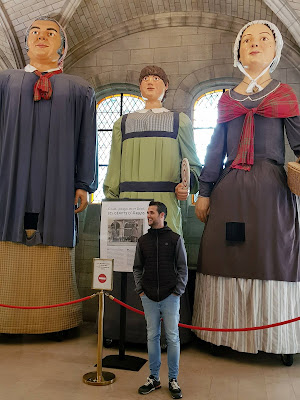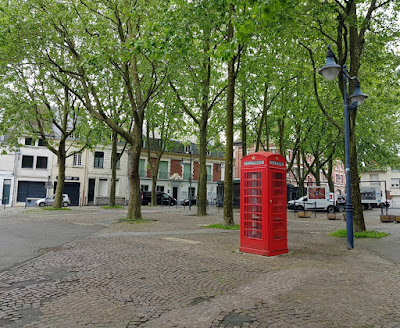This is our last stop before crossing to Folkestone: from here it’s an easy 80 mile motorway run to Calais. However, the weather has deteriorated and we have rain showers and a 16C max temperature, but we are determined to visit Arras to see where Grandpa Sanders was stationed in World War 1. He was a saddler, working just behind the front lines.
Arras was on that front line for most of the 1914-18 war, occupied by the allies but under constant German shell fire. The first photo below, taken before 1914, shows town hall and belfry ( Belfroi de l’Hotel de Ville) in the Place des Heros, one of the two main squares in the city.
Intense shelling by the Germans quickly reduced 90% of Arras
to rubble. This is the same square later in the war.
At the end of the war in 1918, with such complete
destruction, it would have been easiest to build a brand new town. However, it
was decided to faithfully recreate all of the previous buildings using original
plans. So, the town hall sprung to life again, magnificent even on this dull
day.
The whole central area has been faithfully reconstructed in
the Flemish style, some 230 building like these below, so the info board tells
us.
The town hall building is open to visitors, so we enter to
be faced by three giant figures. The tradition of these giants is widespread in
northern France and Belgium, and dates back to the 16th century.
They are meant to represent valiant protectors from the town’s history, clearly
not very effective in that role as they were destroyed in WW1 along with the
rest of the town. Undaunted, the townsfolk revived the figures in the 1920s,
but these fared no better in protecting the town as they were also obliterated
by the Germans in WW2. We move on to the 1980s for the latest version of the
giants, seen here in the photo. Perhaps they’ll do better against the Russians
or Chinese.
Moving just out of the centre, in a rather ordinary square,
we spot an out-of-place object.
The clue is in the square’s name: Place d’Ipswich. Arras is twinned with Ipswich. The whole square contains nothing noteworthy except the church, which is pleasant with a fine stained glass window - modern, but then we’d not expect glass to survive either world war.
We move on and pass an ornate concert hall that to me looks like a fire station – in my mind’s eye, the white doors will suddenly burst open and two keystone-cops type fire engines will thunder forth, brass bells clanging and firemen holding on for dear life.
Now we’re at Arras’s cathedral, a late 18th century build, or rather rebuild following WW1. Then and now photos tell the tale.
We haven’t really done justice to Arras due to poor weather
and lack of time, but we did make one other trip to Arras that was
weather-independent, a guided trip around tunnels known as the Carriere
Wellington.











No comments:
Post a Comment